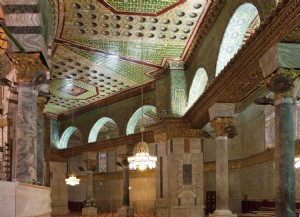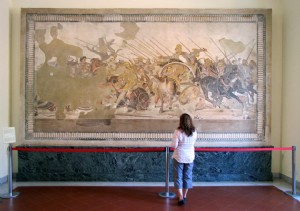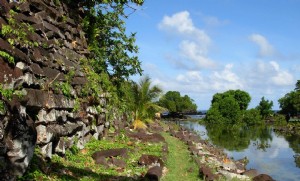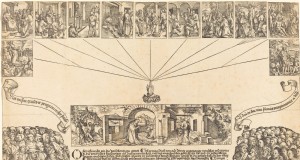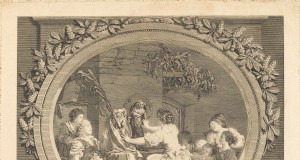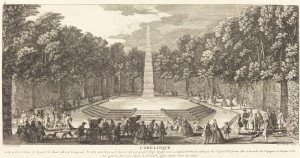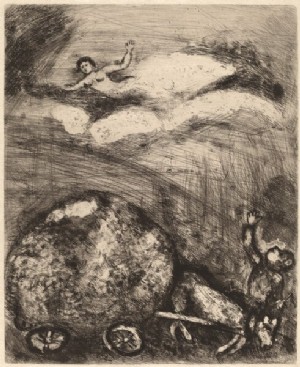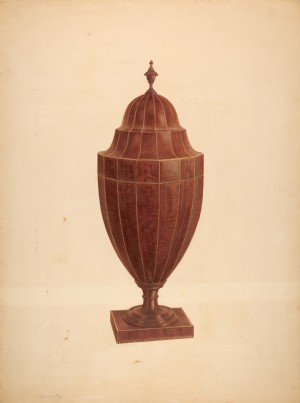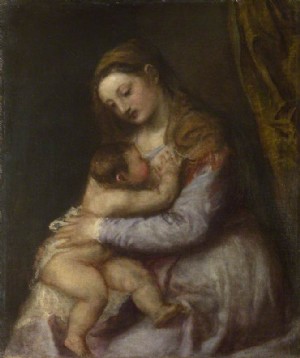Pierres de bannière, Amérique du Nord

Pick Bannerstone incurvé, Glenn Falls, New York, 6, 000-1, 000 avant notre ère, ardoise baguée, 2,7 x 13,6 cm (Musée américain d'histoire naturelle DN/128)
Pourquoi est-ce que dans les écoles à travers les États-Unis, nous apprenons sur les anciens Égyptiens et Grecs et Chinois, mais pas sur les anciens peuples de l'Amérique du Nord ? Dans la moitié orientale des États-Unis entre 6000 et 1000 avant notre ère, à une époque dite archaïque, des milliers d'Amérindiens nomades ont voyagé et vécu le long des fleuves Mississippi et Ohio. pierres soigneusement taillées connues aujourd'hui sous le nom de bannerstones.Elles sont généralement de forme symétrique et percées au centre, amenant les archéologues et les collectionneurs du XIXe siècle à supposer que ces pierres sculptées de manière unique étaient placées sur des tiges de bois hissées dans les airs en tant que « bannières ». néanmoins nous les appelons toujours des bannerstones.

Pick Bannerstone incurvé, Glenn Falls, New York, 6, 000-1, 000 avant notre ère, ardoise baguée, 2,7 x 13,6 cm (Musée américain d'histoire naturelle DN/128)
Pierres de bannière, comme l'ardoise Pic incurvé de Glenn Falls, New York, sont des pierres soigneusement choisies qui ont ensuite été taillées, percé, et des compositions polies.Au centre de cette pierre particulière, un sculpteur archaïque a sculpté une petite crête qui marque et accentue les marques blanc cassé laissées par un ver ou un autre élément biologique pour former ce qu'on appelle une trace fossile incrustée dans la sédimentation de la roche au fur et à mesure de sa formation. les traces fossiles traversent et traversent les bandes naturelles sombres symétriques de l'ardoise (l'ardoise a été formée par deux processus géologiques, un processus de sédimentation, puis un processus métamorphique.) Chaque couleur différente des bandes allant du brun clair au brun foncé indique une couche différente de sédimentation durcie dans la structure rocheuse.

Pick Bannerstone incurvé (inverse), Glenn Falls, New York, 6, 000-1, 000 avant notre ère, ardoise baguée, 2,7 x 13,6 cm (Musée américain d'histoire naturelle DN/128)
D'un autre côté, le cerclage de la pierre forme un motif sensiblement différent, ce qui en fait une ardoise naturelle avec différents motifs sédimentaires de chaque côté de la pierre qui a davantage attiré et mis au défi le sculpteur de composer les deux côtés en une seule composition complexe avec la forme incurvée de la bannière sculptée faisant écho et accentuant les formes concentriques de la bande sombre Étant donné que l'ardoise est une pierre relativement tendre et plus facile à façonner et à percer que les autres pierres, c'est l'une des pierres les plus couramment choisies par les anciens Amérindiens du Nord pour la fabrication de bannières, surtout dans la vallée de l'Ohio.
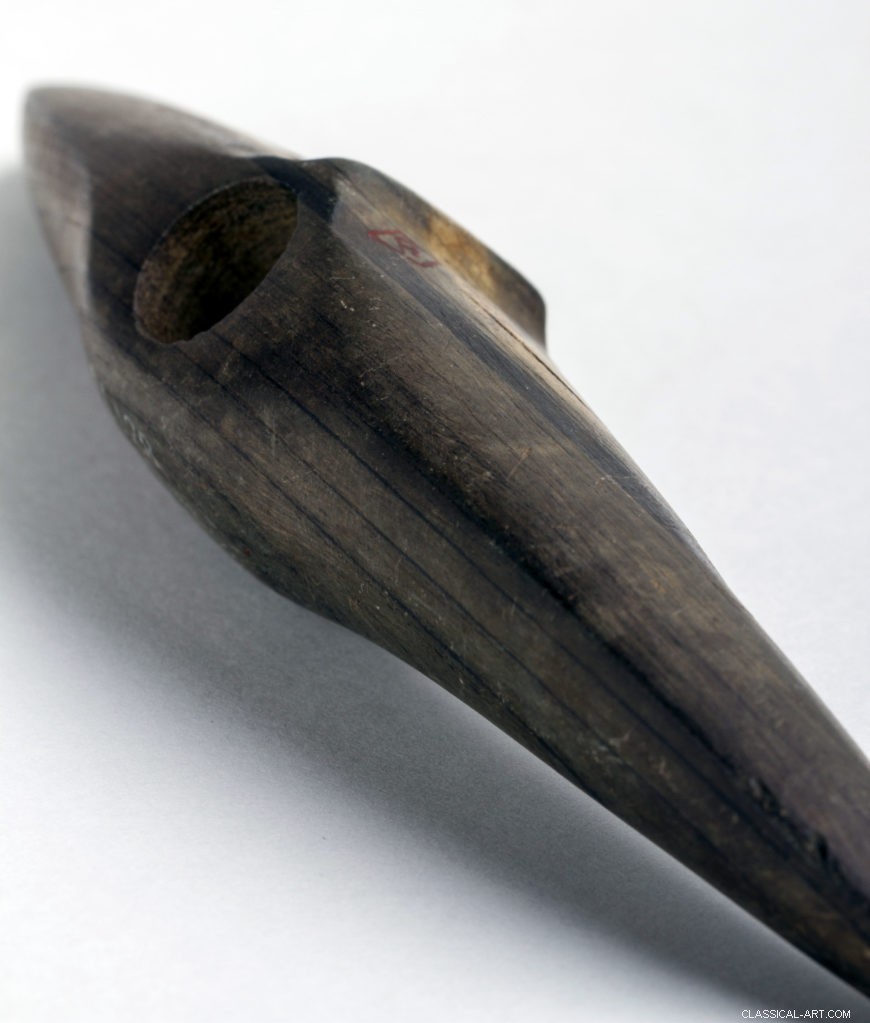
Pick Bannerstone incurvé (en haut), Glenn Falls, New York, 6, 000-1, 000 avant notre ère, ardoise baguée, 2,7 x 13,6 cm (Musée américain d'histoire naturelle DN/128)
Une fois que la pierre brute a été trouvée usée dans la rivière ou extraite d'une carrière à flanc de montagne, le sculpteur prenait une pierre plus dure connue sous le nom de "pierre marteau" pour commencer à picorer puis meuler l'ardoise rubanée, modelant leur travail sur l'un des vingt-quatre types de bannières distincts que les érudits modernes ont définis dans nos études sur ces anciennes œuvres d'art amérindiennes.
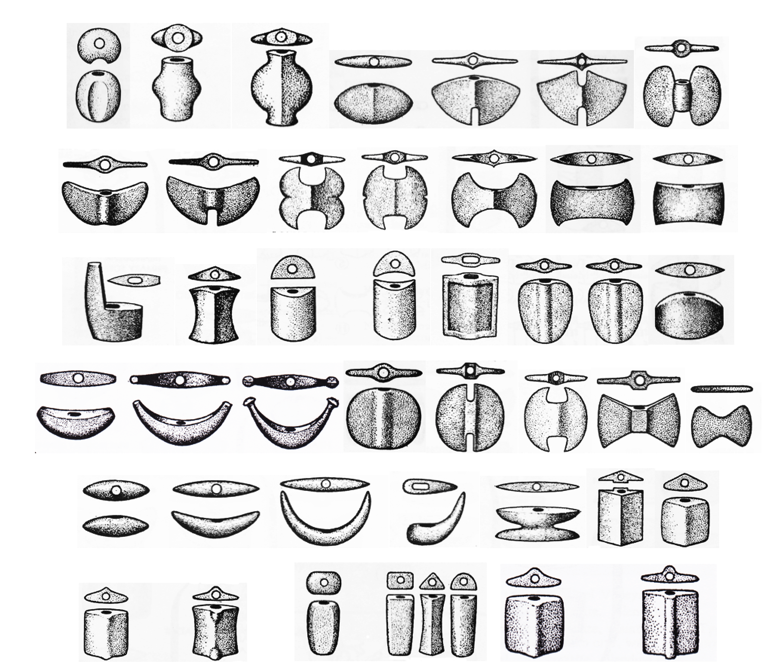
Vingt-quatre types différents de bannerstones identifiés par Byron Knoblock en 1929
Choisir le Pic incurvé taper, l'une des nombreuses formes de bannières particulières au nord-est, le sculpteur a travaillé leur composition pour qu'elle soit précisément centrée sur les deux faces différentes de l'ardoise cerclée, broyer les "ailes" en un bord surélevé qui traverse les bandes d'ardoise sombre, et l'aplatissement, façonnage, et lisser la surface autour de la perforation, individualiser davantage leur travail fini. L'individualité de chaque bannière par rapport à des formes reconnaissables, reconnaissable au sculpteur archaïque et à ceux d'entre nous qui étudient ces pierres aujourd'hui, est une composante intrinsèque de leur fabrication et de leur signification.
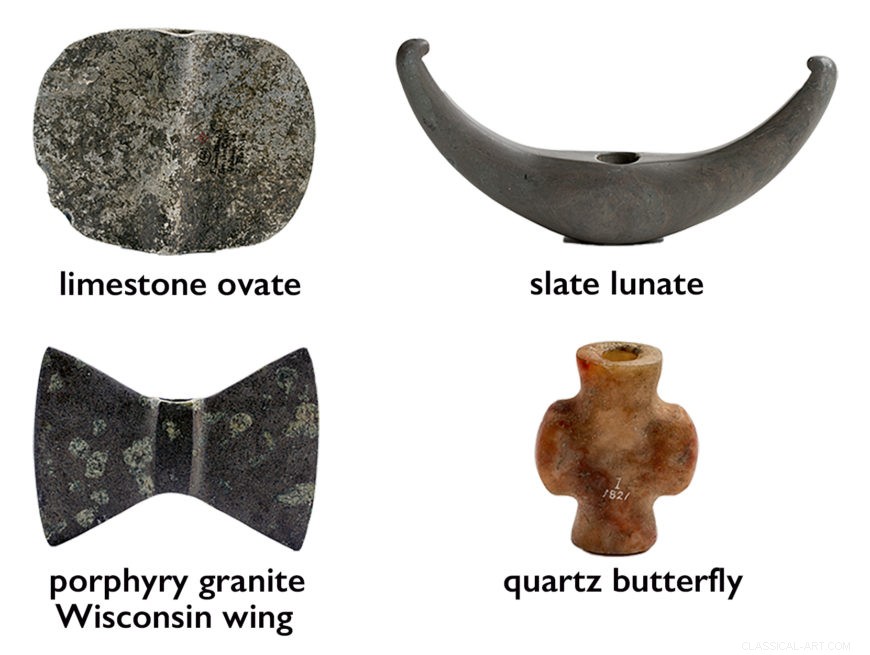
Différents types de bannerstones (dans le sens des aiguilles d'une montre à partir de la gauche :American Museum of Natural History d/144 Limestone; American Museum of Natural History 13/105 Slate; NMNH A26077 Porphyre Granite; American Museum of Natural History 1/1821 Quartz)
Les Bannerstones ont été fabriqués à partir de nombreux types de pierres, y compris celles qui sont sédimentaires, métamorphique, et ignée. La roche sédimentaire que nous voyons dans un bannerstone ovale calcaire est la plus tendre, tandis que l'ardoise (une pierre métamorphique) montre plus de signes de transformation géologique naturelle tels que des bandes que nous voyons dans une bannière de pierre lunaire. La roche ignée est la plus dure et contient souvent des éléments incrustés de divers minéraux lorsque le magma a jailli du noyau de la terre et cooled. This kind of complex igneous surface is evident in a porphyry granite Wisconsin wing bannerstone. Some bannerstone (like the quartz butterfly) are made out of even harder material made of minerals and crystals that would have been even more time consuming and challenging to carve . The relative hardness of the stone chosen by the sculptor would have an impact on the kinds of bannerstone forms they would or could sculpt. The thin wings of slate and even granite bannerstones could not be carved out of quartz, while the seemingly thick rounded form of a Quartz Butterfly bannerstone might appear unfinished if it were carved in slate.
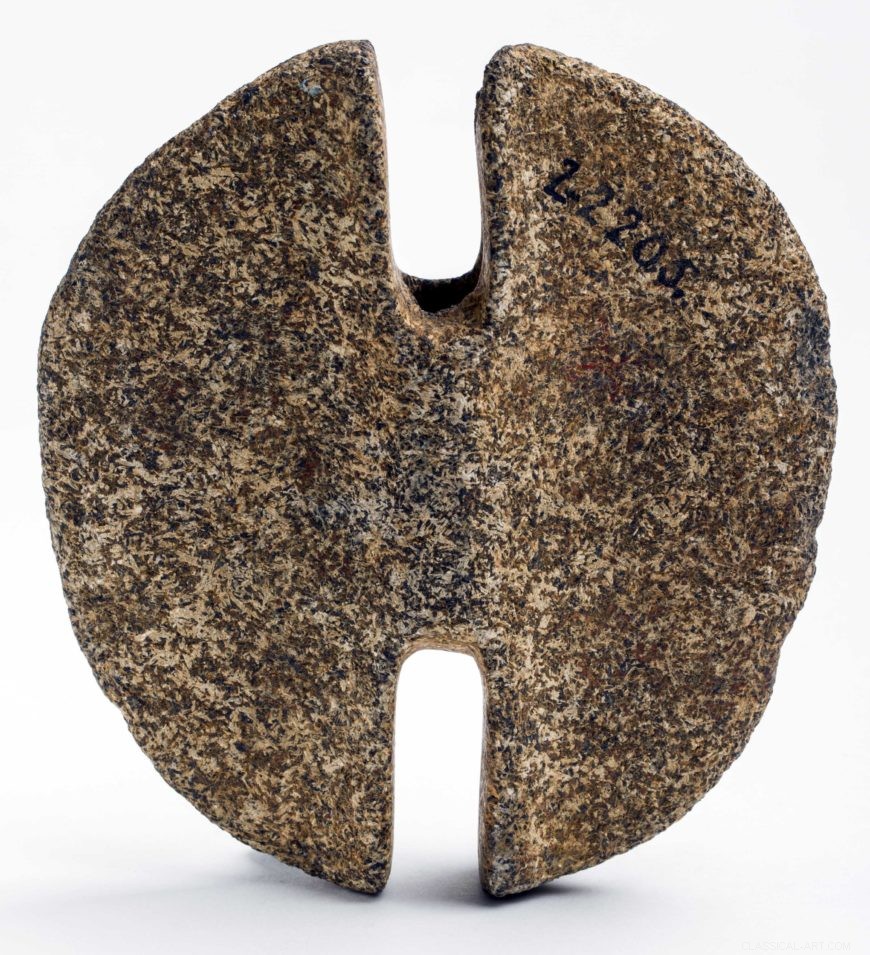
Southern Ovate Preform Bannerstone; Habersham County, Georgia, 6, 000 – 1, 000 B.C.E., igneous, coarse-grained alkaline, 11.5 x 10.3 cm (American Museum of Natural History 2/2205)
Unfinished bannerstones
Whatever their shape or relative state of completion, all bannerstones were made using river-worn pebbled hammerstones to peck, grind, and polish the surface. Some bannerstones, however, were intentionally left in a partial state of completion known as a “preform” such as a Southern Ovate from Habershan County, Georgia.
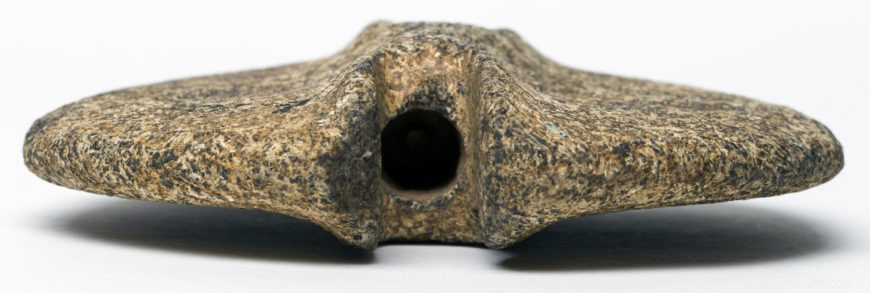
Southern Ovate Preform Bannerstone; Habersham County, Georgia, 6, 000 – 1, 000 B.C.E., igneous, coarse-grained alkaline, 11.5 x 10.3 cm (American Museum of Natural History 2/2205)
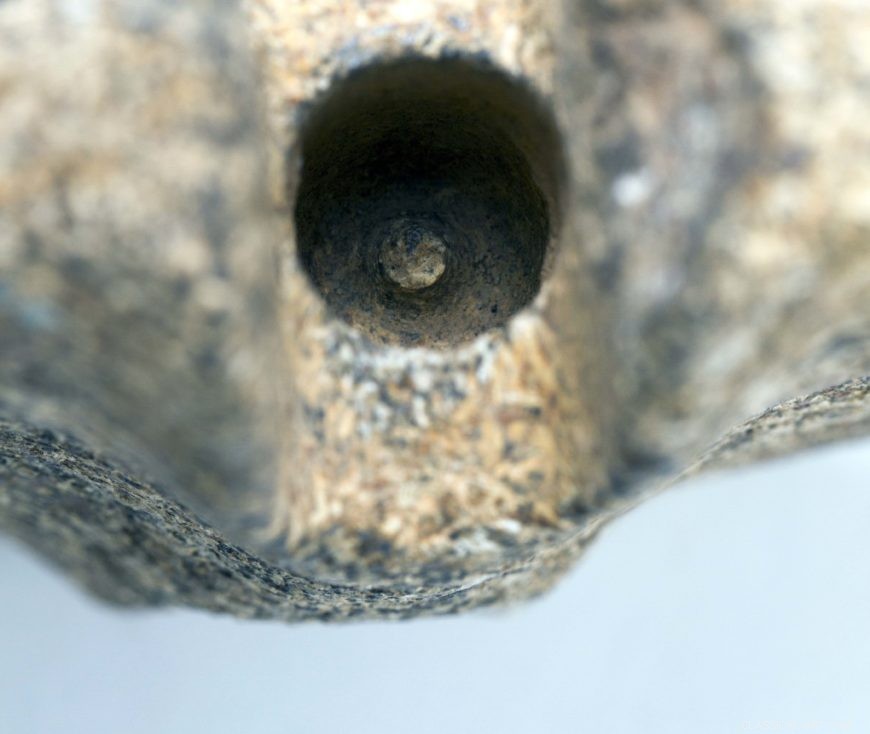
Southern Ovate Preform Bannerstone; Habersham County, Georgia, 6, 000 – 1, 000 B.C.E., igneous, coarse-grained alkaline, 11.5 x 10.3 cm (American Museum of Natural History 2/2205)
This bannerstone is partially drilled at the spine on one side with a hollow cane or reed that grow along the banks of rivers, and undrilled at the other side. The reed itself is hollow and when rubbed briskly between the hands with the application of water and some sand, can drill through slate, granite and even quartz. With this stone the partial passing of the reed leaves concentric circles on the inside of the perforation and a small nipple visible here that would fall out the other side when the perforation was complete. The medium to coarse-grained igneous rock is left unpolished, just as the ovate form and perforation are left unfinished. Scholars believe that preforms such as these were often buried in this state, or meant to be finished at a later date by another sculptor in a different location. The kind of granite we see here is unique to this region of the Southeast and so would likely have been valuable as a trade good further west along the Mississippi where there was little or no stone available. By partially completing the Ovate form, even partially drilling the perforation the sculptor of this southeastern stone increased the value of the stone while leaving the finish work to whomever acquired this Ovate in this preform state.
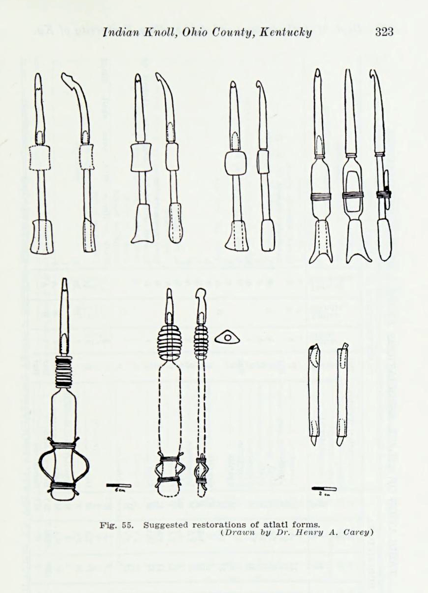
Illustration in William S. Webb, Indian Knoll , 1946 (publication of his 1937 study at Indian Knoll), p. 322
Hunting tools?

How to use an atlatl, here with an arrow (mage:Sebastião da Silva Vieira, CC BY 3.0)
In 1937, William S. Webb, at the University of Kentucky, with his large crew of Works Projects Administration (WPA) workers funded by the New Deal in the 1930s, excavated 880 burials at the Indian Knoll site in Western Kentucky. Amongst these 880 human burials, Webb found 42 bannerstones buried with elements of throwing sticks known as atlatls. Webb proposed that the bannerstones were weights that had been made to be placed on the wooden shafts of these hunting tools. The first inhabitants of Eastern North America used atlatls instead of the bow and arrow until 500 C.E. The two-foot long shaft of the atlatl could propel a six-foot spear and point great distances with accelerated speed and accuracy. It is a tool invented and used in Eurasia and Africa as early as 40, 000 B.C.E. and ubiquitous throughout the Americas after it began to be inhabited thousands of years later.
Though many scholars after Webb, including myself, agree that many bannerstones were likely carved and drilled to be placed on atlatl shafts, this particular hypothesis raises as many questions as it may appear to answer. For instance why would these Native American sculptors dedicate so much time to an atlatl accessory that appears to have nominal if any effect on the usefulness of the tool? This raises other unanswered questions about the usefulness of beauty and how aesthetics, pleasure, and play are significant, though often overlooked, elements of ancient Native North American art.
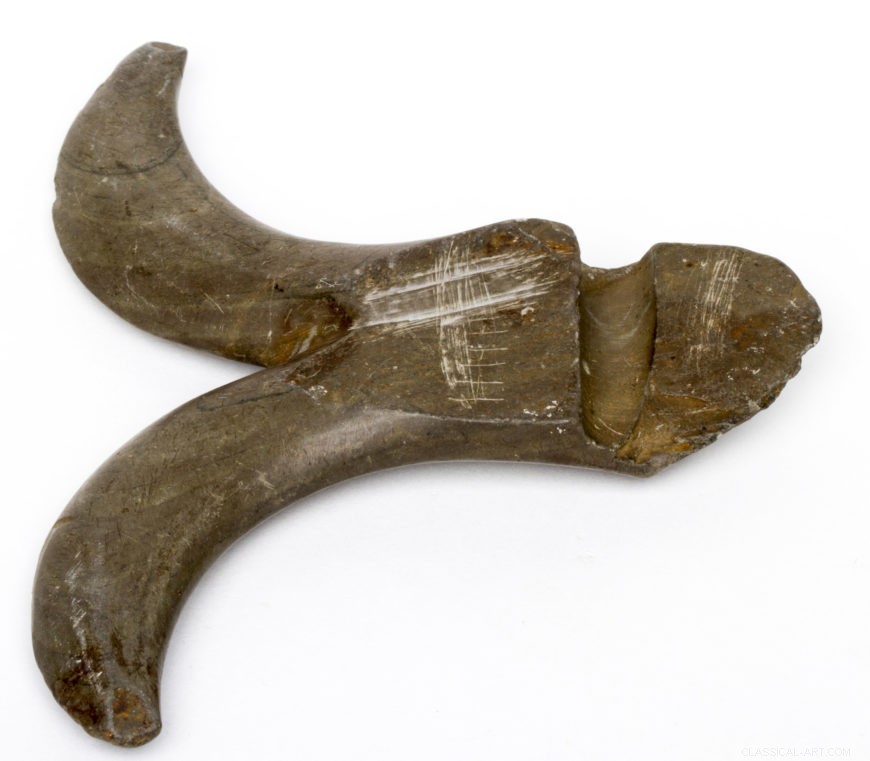
Partially destroyed double crescent type bannerstone (American Museum of Natural History DM 333)
NAGPRA
Since Webb’s 1936 excavation at Indian Knoll, Kentucky, remains and belongings of Native Americans are no longer simply there for the taking for the collector’s shelf, college laboratory, or museum case. Especially with the passage of the Native American Graves Protection and Repatriation Act of 1990 (known as NAGPRA), funerary remains of Native Americans (bodies and objects placed with these bodies in burials) are protected from being disturbed or excavated unless permissions have been granted by Native communities culturally affiliated with the burials. [1] Native American funerary objects already in federal agencies or museums and institutions that receive federal funding are to be made available to culturally affiliated communities that have the right to request their repatriation. Whatever the aims of post-Enlightenment science or the elucidating potential of the exhibition of artworks may be, these ideological motivations must be negotiated with and in light of the desires, memories, practices, and philosophical underpinnings of the Native American people and their descendants who often buried their dead with bannerstones and other burial remains.
Currently the William Webb Museum has recently removed all photographs of the 880 burials and 55, 000 artifacts that Webb excavated at Indian Knoll in 1936 and will no longer allow scholars to study these remains “until legal compliance with NAGPRA has been achieved.” What “legal compliance with NAGPRA” specifically means for the remains including bannerstones excavated at Indian Knoll is profoundly complex. No living communities of Native Americans trace their direct line (in legal terms, known as “lineal descendants”) to the Archaic people who built this shell mound in which they buried their dead along with valued objects including broken and unbroken bannerstones. With the ratification of the Indian Removal Act of 1830, the Shawnee and Chickasaw communities that lived in Western Kentucky in the 19th century were forced to move west to Oklahoma. [2] How the William Webb museum will choose to adhere to NAGPRA and what they will do with burial remains from Indian Knoll will set a precedent unfolding into the present about how to collaborate with living Native American communities (even those who are not “lineal descendants”), and how to mindfully regard the past lives of the Ancient people of North American, their human remains along with the multitude of things they made, valued, and arranged in and outside of burials.
Intentionally broken?
Since the 19th century, many bannerstones were found in ancient trash piles known as “middens” as well as ritual burials of things known as “caches” and many more in human burials in subterranean or earthen mound architecture. A large number of bannerstones have also been found broken in half at the spine where they are most fragile due to the thin walls of the drilled perforations.
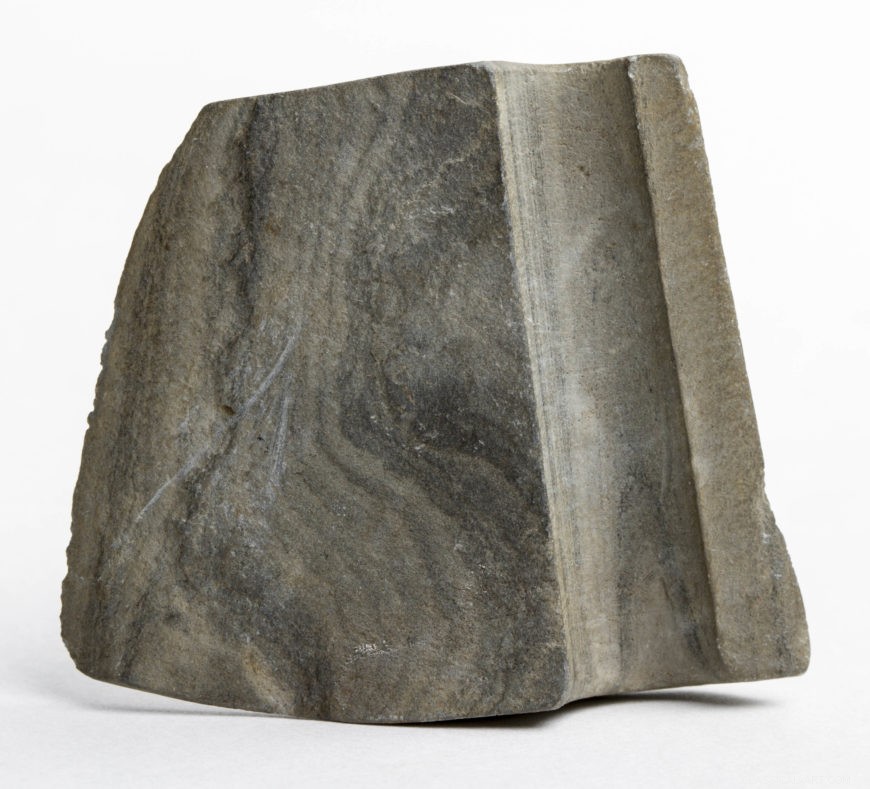
Broken butterfly type bannerstone (American Museum of Natural History 20.1/5818)
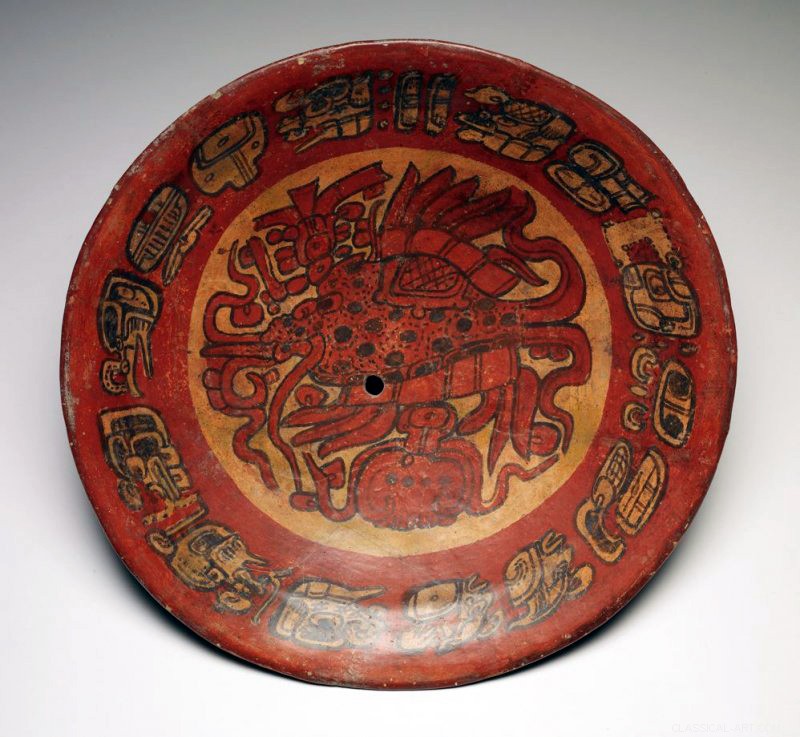
Kill hole in the center of a plate with a supernatural fish, 7th century, Late Classic Maya, earthenware and pigment, 10.5 x 40.6 x 40 cm, Guatemala (De Young Museum)
The intentional nature of these acts of breaking are evident in the placement of pieces together with no sign of wear along the broken edges, carefully arranged with other valuable objects. Archaeologists and historians of the ancient art of the Americas amongst the 8th century-Maya (of Mesoamerica) or 12th-century Mimbres art (of what is today the southwestern U.S.) have often identified this practice as “ritually killing” the object before burial. Though these bannerstones in most cases were intentionally broken by the very people who carved them (most likely just before burial), the meaning and purpose of this act further reveals something about the conceptual and even poetical importance of these sculpted bannerstone forms. Rather than “ritually killing, ” bannerstone makers as well as other artists of Ancient America appear to be repurposing artworks, using them in one way at first, then reconceptualizing them to accompany their dead underground, as a kind of memory-work for the living not entirely unlike the carefully constructed exhibition spaces or storage units of our museums. For the Indigenous people of the Americas the earth itself was often seen as a repository for cultural and personal objects, an underground space that was curated with things that continued to have meaning for the lives of communities for decades and even centuries.
Notes:
[1] More on NAGPRA can be found here and here. [2] Read about the Indian Removal Act at the Library of Congress.
